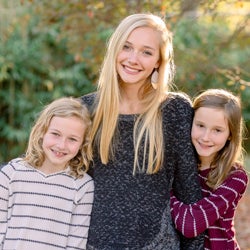Epilepsy
It’s not always easy to spot a potential problem with a young child. Gut instinct guided Tom and Louisa Jeffries when their oldest daughter, Reed, was acting a bit out of sorts. “She was having trouble listening and paying attention,” Louisa said. “I could say something directly to her, but she wouldn’t respond and then act like she hadn’t heard me. It was very strange for her.” After a few more subtle but strange instances with Reed, Louisa took her to the pediatrician who suspected seizures. They were referred to Children’s of Alabama for an electroencephalogram (EEG) and consult with pediatric neurologist Dr. Tony McGrath. Dr. McGrath confirmed that Reed was experiencing absence seizures, which are common in children and causes them to “blank out” for a short period of time. “He thoroughly explained it to us and told us what to expect,” Louisa said. “He was very compassionate and positive. He put Reed on anti-seizure medication, which began controlling the seizures very quickly.” Throughout her childhood, Reed visited Children’s for EEGs and checkups with Dr. McGrath. Slowly she was weaned off the medication, but the seizures returned and Reed experienced a different type of seizure, a tonic-clonic seizure that changed her diagnosis to primary generalized epilepsy. Around this time, the Jeffries noticed similar characteristics in one of their younger twins, Anne. “It was harder to tell with Anne because she was more apt to daydream, but we suspected it,” Louisa said. “Then one day she had a tonic-clonic seizure and we knew.” The Jeffries took Anne to see Dr. McGrath, who prescribed her the same anti-seizure medication as Reed. “Thankfully, Anne responded to the medication just as well as Reed,” Louisa said. Both Reed and Anne have since been weaned off anti-seizure medication and are seizure-free. Though they are not currently living with active epilepsy, the Jeffries’ focus on helping others continues. Reed and Anne, along with Anne’s twin Eva, hosted a lemonade stand fundraiser, Lemonade for Livy, which aims to raise epilepsy awareness through the Epilepsy Foundation. Eva is heavily involved with epilepsy advocacy through the Epilepsy Foundation’s Kids Crew. “She earns pins for different aspects of epilepsy advocacy, and so far, she’s earned seven out of eight,” Louisa said. “Eva has written letters to legislators about supporting funding for epilepsy programs, made cards for the neurology clinic team at Children’s and even participated in a virtual walk to end epilepsy.” As the family does what it can to advocate for others with epilepsy, Louisa never fails to remember the help they received from Children’s. “It’s a world-class hospital with an amazing staff of doctors, nurses and technicians who are so knowledgeable, supportive, compassionate and kind,” she said. “The environment there is so caring and comfortable and even joyful. We’re so thankful for the support we received from Children’s. I can’t imagine what it would be like to not have a resource like Children’s.” Pictured, left to right: Anne Jeffries, Reed Jeffries and Eva Jeffries







